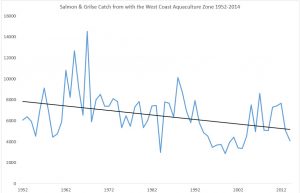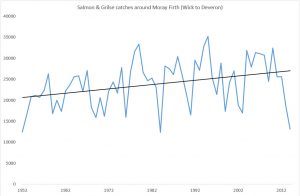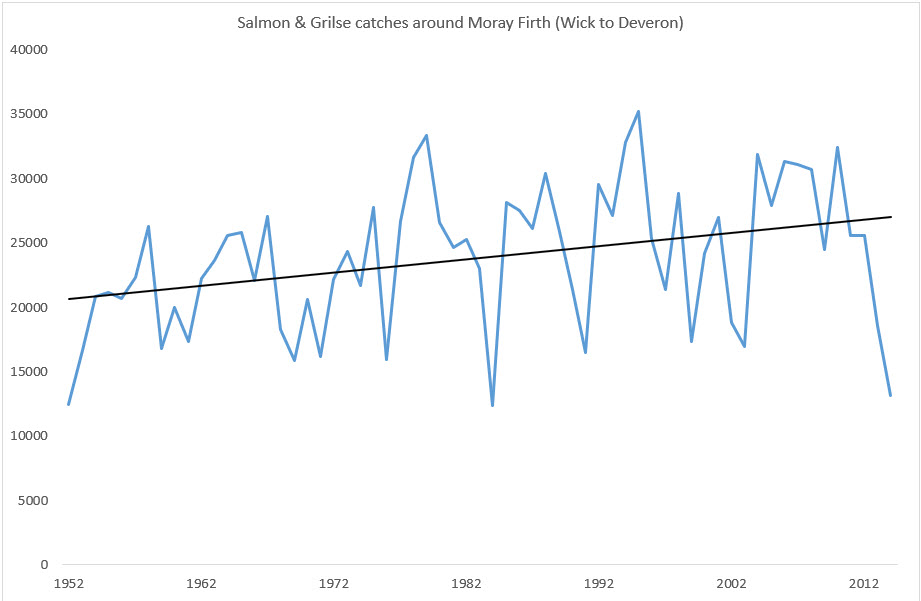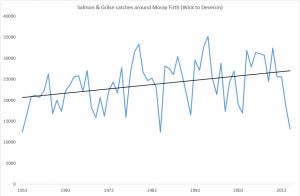Anger and condemnation: Seafood News reports that the news of Young’s Seafood’s decision to close the Pinney’s business in Annan, Southwest Scotland, have been met with anger and condemnation. Both the Scottish and British Governments have been asked to intervene because the business is one of the largest employers in the area with a workforce of 450. The company have said that Pinney’s is no longer ‘financially sustainable’ and that they plan to move the operation to Grimsby. The local MSP, Colin Smyth said that this is a devastating blow to an already fragile local economy.
Pinney’s primary business is about salmon and we, at Callander McDowell, find it rather surprising that this announcement has not yet been linked to the uncertainty within the salmon farming industry arising from the massive campaign of negative publicity levelled against it. This has led to the current enquiries from both the environment and rural economy committees in the Scottish Parliament, that appear to portray salmon farming as an unnecessary evil, at least that is the impression from the press coverage. Sadly, the salmon industry is not getting a fair hearing and we are now seeing the inevitable consequences – the loss of 450 jobs.
In the past, the salmon industry has created jobs where there were no jobs. With growth becoming increasingly difficult, the prospect of future job creation is turning into job losses. Perhaps, if those in a position of power started to listen to the salmon industry as well as those with their own private agendas then maybe the latest anger and condemnation can be turned into hope and prosperity.
Lost their way 1: The Times newspaper reported the launch of an international project that aims to track migrating Atlantic salmon in an attempt to halt the decline of the species. The Atlantic Salmon Trust’s Missing Salmon project aims to discover why the marine survival of wild salmon has fallen by 70% over the last twenty-five years. The project is centred on the Moray Firth in the north east of Scotland, because it is from where 20% of all salmon from the UK migrate to sea.
The Times said that environmentalists have criticised the choice of the east coast location. Don Staniford, director of Scottish Salmon Watch and the Global Alliance Against Industrial Aquaculture told the newspaper ‘Why the hell are they focussing in the east coast when all the salmon farms and lice/disease problems are on the west coast.?’
We hope that all those who depend on Mr Staniford for ‘ammunition’ to fire at the salmon farming industry will release that by making this statement he doesn’t actually have an understanding of the problems affecting wild salmon and that many of his claims about salmon farming are actually unjustified. He is just out to blame salmon farming for no matter what. We suspect it won’t be too long before salmon farming is even blamed for Brexit.
Mr Staniford doesn’t appear to realise that wild salmon are in trouble across all their range and however he wishes to spin this, the reality is that the reported 70% decline in wild salmon returns occur even where there is no salmon farming. It would seem a waste of time initiating a tracking programme on the west coast because critics like Mr Staniford claim that west coast salmon stocks have already been wiped out and that those that do survive are likely to die from sea lice infestation anyway.
Even though critics like Mr Staniford and Salmon & Trout Conservation Scotland claim that salmon farming has destroyed west coast salmon stocks, the catch data of wild salmon and grilse from the west coast ‘Aquaculture Zone’ appears to tell a different story.

Clearly, the trendline shows a downward trend of catches throughout the whole period from 1952 to 2014. However, this is not surprising since as the Atlantic Salmon Trust point out there has been a 70% decline in returning salmon since the 1990’s. The most notable feature on this graph is the big dip that occurs around then and the subsequent increase during the early 2000s. If salmon farming is responsible for declines in west coast salmon, why have catches increased?
The answer is that the dip was caused by a reduction in fishing effort resulting from widespread claims that salmon farming had destroyed west coast angling. Under such circumstances, it is understandable that anglers decided to fish elsewhere, which they did in large numbers. The fishing effort fell and as a result, so did the catch. However, when anglers began to realise that west coast rivers still had salmon, they started to return, and catches returned to previous levels.
Of course, every year is different, and it is not easy to compare annual catches from the early 1950’s with those of a recent time. Yet, if the data from the graph is averaged to produce a 10-year average catch then what is most surprising is that the 10 year catch figure from the end of the series is actually higher than from the beginning – 6112 compared with 6228 fish. It doesn’t seem salmon farming has had much impact on wild salmon catches at all.
It shouldn’t be too long before we find out whether this observation is confirmed by the Marine Scotland Science SARF smolt release project. We understand that the final draft report is out for peer review. We, at Callander McDowell, certainly look forward to its publication as we have been told that this experimental approach is the only way to determine whether sea lice from salmon farms is having a detrimental impact on wild fish. Certainly, the graph above doesn’t seem to suggest that they are.
Meanwhile, we were interested to see that Don Staniford has called for public donations to fund the ‘Scottish Salmon Watch’ organisation of which he is a director (www.scottishsalmonwatch.org ). Interestingly, any donations are to be paid into a private bank account named ‘Donald C Staniford’. Surely, the public are being misled just are they are by many of his claims against the salmon farming industry.
Lost their way 2: We, at Callander McDowell are slightly puzzled by the AST’s Missing Salmon project. Their press release states that they will be ‘tagging the fish and tracking their progress form their spawning ground and back again’ which suggests that the fish will be tracked from the rivers up to their feeding grounds and then back again to their home river, yet it also states that the fish will be ‘tagged as they begin their journey from their home river towards the sea. Fish are recorded as they pass strategic points – which will help determine how many fish make it to the ocean and where mortality occurs’. This suggests that the fish will only be only tracked down the various river systems that surround the Moray Firth and not out in the open sea.
Our understanding is that the main mortality occurs out at sea and therefore tracking smolts down the rivers is not really going to contribute to understanding why the majority of fish die. In addition, the Scottish Government recently announced a half a million-pound project to track wild salmon in Scottish rivers. It would seem that both these projects are aiming to do the same thing.
There does seem to be a view that as it will be impossible to address any problems that do occur out at sea then the focus should be on what can be done in freshwater as this is where action can be taken. Yet, if the majority of problems do occur at sea, then this focus does appear to be all wrong. Certainly, AST say that over the last twenty-five years, wild salmon stocks have decline by 70%, yet when rod catches from the Moray Firth are examined, it does appear that more salmon are being caught, not less.

Its possible that the AST have distributed their plans for consultation but as with most of the wild fish sector, they never seem to reach those of us working in the farming industry. The farming sector is often blamed for most of the problems with wild fish, but we are never seen as helping with the solution.
From our position on the outside looking in, we are not convinced by the AST project. We don’t think it will really address the fundamental issues, yet we think that there are solutions but because they come from outside the traditional wild fish sector they are discounted regardless. We have seen how closed the wild fish sector is to wider discussion. For example, we hoped our book would help initiate discussion about salmon farming’s impact on wild fish but instead, the wild fish have done their best to ignore its existence. Simple, if they don’t read it, then there’s nothing to discuss.
In much the same way, if the wild fish sector doesn’t hear about potential solutions to the current problems, then they can’t be considered.
When it comes to wild fish mortality, we are surprised how little interest the wild fish sector shows in the work of Jens Christian Holst. This former researcher from Norway’s Institute of Marine Research believes that the underlying problem for wild salmon is that since the late 1960’s ICES have taken a very cautious approach to the management of herring and mackerel stocks in the North East Atlantic. These stocks have grown in size well beyond the official estimates and are simply hoovering up all the food in salmon’s traditional feeding grounds. They are even eating their way through the salmon stock as well. Jens Christian believes that this is why grilse have now largely disappeared from Scottish rivers. Instead, those salmon that can avoid being eaten and become large enough to turn on their predators become the very large multi-winter salmon that are returning to Scottish waters.
The solution is that wild salmon organisations such as NASCO should be asking ICES to revaluate herring and mackerel stock levels and to increase quota levels to manage the stock to more reasonable levels that allow food stocks to develop so that migrating salmon have food to eat.
At the same time, there is more the wild sector can do at home. The River Carron Restoration project, another success story largely ignored by the wild fish sector has shown that increasing the number of smolts leaving a river can increase the number of fish returning. Unfortunately, the wild fish sector has talked themselves into believing that hatcheries do more damage than good, probably because they don’t like spending money on something that they think should occur naturally. They should be talking to Dr Bob Kindness about his work, but they won’t.
Instead, the AST seem to think that tracking fish will solve all their problems. We’ll have to wait and see.
Engaged in debate: In an article in the Courier newspaper, Jenny Hjul commented on the recent news that campaigners had rejoiced because the Scottish Government had failed to negotiate a get out clause with the US for Scottish farmers regarding the killing of rogue seals. Despite a failure to control guns and the many deaths that they bring, the US wishes to ban seafood imports that have been associated with seal deaths. This is of course a backdoor way of protecting domestic salmon production which is why the Scottish Government failed in their attempt to help the Scottish salmon industry.
Jenny suggests that even though seal deaths are less than 0.1% of total population and that everything is being done to reduce that further, activists argue that even one seal death is one death too many and that the industry should change its practices regardless of the cost. They would prefer that the entire rural economy is destroyed if it meant one seal could be saved. The problem is that seal populations are now exploding in number, especially on the west coast. Something will eventually have to give.
However, it is not just activists who are pleased. Green Party MSP Mark Ruskell welcomes the news of the Government’s failure to secure an exemption for Scottish salmon farms. Jenny says that his priority is not about saving seals but about shutting down the salmon farming industry and as such he has sided with the most strident anti-farming campaigners. He sits on the Parliament’s Environment Committee and some of the content of their report on salmon farming clearly reflects his views.
Mr Ruskell responded to Jenny’s comments in a letter to the Courier in which he said that Jenny should embrace the industry’s failings rather than attempting to shame its critics. He said that shooting the messenger along with the seals will not address the problems.
Mr Ruskell provides a long list of problems that he believes the industry causes to the environment. However, the real problem is that he is only willing to listen to the critics and not to those from the industry. He is thus unaware of the progress that the industry has made over the years with regard to all aspects of environmental impacts. Instead he repeats the oft repeated mantras that sea lice from salmon farms are killing wild salmon; that escapes are compromising the genetics of wild fish; that the seas are being destroyed to feed farmed salmon and so on. The industry is more than willing to engage in discussion, sadly it is the critics who are not. We, for one have written to Mr Ruskell but have yet failed to receive a reply. So much for engagement.


